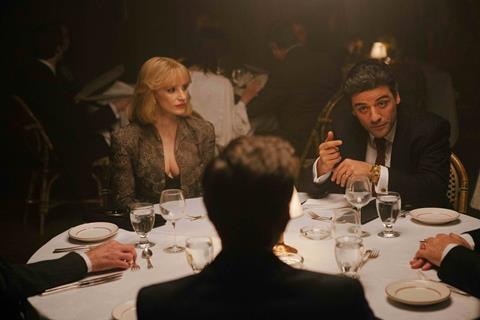Dir/scr: J.C. Chandor. US. 2014. 125mins

With his third feature, writer-director J.C. Chandor continues to cement a reputation for making distinctive, intelligent films of which no two are alike. The follow-up to the talk-heavy Wall Street ensemble drama Margin Call and the minimalist survival story All Is Lost, A Most Violent Year finds Chandor operating on a much larger canvas, tracking the rot of the American Dream through the eyes of an immigrant gangster in New York City in the early 1980s. Muddled and self-consciously dour, A Most Violent Year is less persuasive when it tries for sweeping social commentary. But Chandor’s relentless examination of his flailing protagonist, played with great inner fire by Oscar Isaac, gives this insular character study a weary gravity that’s captivating, albeit a bit mannered.
Premiering at AFI Fest before coming to theatres in late December, A Most Violent Year will be a stylish, moody entry in the annual Oscar sweepstakes, with distributor A24 hoping that Isaac and co-star Jessica Chastain will corral art-house crowds. The movie’s crime-drama trappings may also be a lure, although Chandor’s disinterest in carting out mobster clichés or high-octane action sequences will probably keep this decidedly introspective offering from achieving massive crossover success. Good reviews and key nominations will be crucial to help the film stay visible during a crowded award season.
Set during the winter of 1981 in New York City, the film stars Isaac as Abel Morales, a well-coiffed, sharp-dressed businessman who owns a heating-oil company. Married to no-nonsense, sharp-tongued Anna (Chastain), Abel refuses to see himself the way anyone else would: as a mobster trying to get ahead in a competitive market. Insisting that he does things the right way — he doesn’t have anyone whacked, and he abhors the word “gangster” — he nonetheless must respond when his drivers begin being intimidated and robbed by armed thugs. Are his mob rivals behind the attacks? And can he maintain his market share without resorting to violence, which could jeopardize a crucial bank loan he needs to stay afloat?
Shot with deep shadows and a gloomy splendour by rising cinematographer Bradford Young (Ain’t Them Bodies Saints), A Most Violent Year aspires to the gritty, grownup drama of 1970s crime films like The Godfather. As is Chandor’s preference, the movie thrusts us into the middle of its characters’ world, letting viewers slowly deduce the nomenclature and customs of this particular ecosystem. As a writer, he’s superb at avoiding needless exposition, instead peppering the dialogue with tantalizing references to back story and past incidents that create a rich tapestry of the participants’ lives.
Thanks to films such as The Godfather and Goodfellas (to say nothing of TV’s The Sopranos), the gangster ethos has been well explored, and Chandor can’t fully escape those works’ influence. But a certain amount of conventionality is mitigated by his insistence on giving us characters who barely acknowledge their lifestyle. There are a few guns in A Most Violent Year, but they’re rarely used — rather, it’s the threat of violence that hangs heavy over Abel and Anna. Conferring with his ethically slippery lawyer (Albert Brooks) or speaking tersely but cordially with a competitor (Alessandro Nivola), Abel comes across as a smart, pragmatic man who knows that everything he treasures — his family, his business, the self-worth he derives from his success — hangs in the balance, giving each encounter and even each word a considerable weight.
As he showed in Margin Call, in which a fleet of expert actors delivered his clever rat-a-tat-tat dialogue with panache, Chandor demonstrates a gift for terse, telling exchanges in A Most Violent Year. This is a movie where people say the bare minimum so as to better protect their interests, even if sometimes Chandor overdoes Abel’s tough-guy fatalism. Letting character motivations dictate the storytelling and not vice versa, A Most Violent Year creates a pleasingly dizzying web of anxieties to ensnare Abel: The D.A. (led by David Oyelowo) is going to bring charges against his business; his trucks are being hijacked by mysterious assailants; an unknown man came to his house in the middle of the night to inflict harm; and his plan to acquire a crucial piece of land could collapse, potentially dooming his company.
Isaac embodies Abel’s grim determination beautifully, essentially offering a dramatic counterpoint to his struggling folk singer in the darkly comic Inside Llewyn Davis. In both movies, the actor musters an evocative stillness that suggests turbulent undertows beneath the placid surface. (Plus, his eyes convey exhaustion, melancholy and fiery conviction effortlessly.) Perhaps by design, Chandor keeps us at a distance from Abel so that we’re never quite sure what he’s thinking. But Isaac makes that opacity intriguing: We sense that he’s someone who has worked very hard to pull himself out of poverty and now wants to squash his competitors, whom he sees as being given so much more by their families. But such a reading is complicated by Anna’s own feelings about her husband, and their relationship is almost always right on the precipice of constant tension. (Indeed, her big confrontation scene near the film’s end twists our understanding of Abel’s self-righteous vision of himself.)
Chandor and Isaac’s close attention to Abel comes at the expense of other narrative elements, however. Chastain’s Anna soon drifts away from the film, becoming a bland sounding board for her husband. The actress can do little more than give the character a slightly bawdy personality while draped in fabulous Giorgio Armani outfits, which doesn’t compensate for an underwritten role.
Additionally, A Most Violent Year goes limp when Chandor tries to tie Abel’s dilemma to a larger social portrait of American aspiration. Though Alex Ebert’s doom-laden score lends the proceedings a grey-skied majesty, other attempts at gravitas reek of self-importance. (Fair or not, it’s simply impossible to watch a movie with scenes of the still-standing World Trade Center in the background and not think that the filmmaker is trying too hard to make a point about the country’s faded promise.)
What Chandor has to say about political corruption, questionable business ethics and the fallacy of the American Dream isn’t particularly revelatory. As with his previous two films, A Most Violent Year is strongest when we simply watch his fascinating characters negotiate their dangerous environments, whether it be a Manhattan boardroom, a raging ocean or the sharks circling a small-time gangster with delusions of grandeur.
Production companies: Participant Media, Image Nation Abu Dhabi, FilmNation Entertainment, Before The Door, Washington Square Films, Old Bull Pictures
US distribution: A24, www.a24films.com
Producers: Neal Dodson, Anna Gerb, J.C. Chandor
Executive producers: Jeff Skoll, Jonathan King, Glen Basner, Joshua Blum, Kerry Orent
Cinematography: Bradford Young
Production design: John P. Goldsmith
Editor: Ron Patane
Music: Alex Ebert
Website: www.NewYorkCity1981.com
Main Cast: Oscar Isaac, Jessica Chastain, David Oyelowo, Alessandro Nivola, Elyes Gabel, Albert Brooks



















